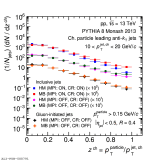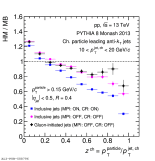Figures from paper submitted to European Physical Journal C - Particles and Fields
Abstract:
The first measurement of the multiplicity dependence of intra-jet properties of leading charged-particle jets in proton-proton (pp) collisions is reported. The mean charged-particle multiplicity and jet fragmentation distributions are measured in minimum-bias and high-multiplicity pp collisions at $\sqrt{s}$ = 13 TeV using the ALICE detector. Jets are reconstructed from charged particles produced in the midrapidity region ($|\eta|<~0.9$) using the sequential recombination anti-$k_{\rm T}$ algorithm with jet resolution parameters $R=0.2$, 0.3, and 0.4 for the transverse momentum ($p_{\rm T}$) interval 5-110 GeV/$c$. High-multiplicity events are selected by the forward V0 scintillator detectors. The mean charged-particle multiplicity inside the leading jet cone rises monotonically with increasing jet $p_{\rm T}$ in qualitative agreement with previous measurements at lower energies. The distributions of jet fragmentation function variables $z^{\rm ch}$ and $\xi^{\rm ch}$ are measured for different jet-$p_{\rm T}$ intervals. Jet-$p_{\rm T}$ independent fragmentation of leading jets is observed for wider jets except at high- and low-$z^{\rm ch}$. The observed hump-backed plateau structure in the $\xi^{\rm ch}$ distribution indicates suppression of low-$p_{\rm T}$ particles. In high-multiplicity events, an enhancement of the fragmentation probability of low-$z^{\rm ch}$ particles accompanied by a suppression of high-$z^{\rm ch}$ particles is observed compared to minimum-bias events. This behavior becomes more prominent for low-$p_{\rm T}$ jets with larger jet radius. The results are compared with predictions of QCD-inspired event generators, PYTHIA 8 with Monash 2013 tune and EPOS LHC. It is found that PYTHIA 8 qualitatively reproduces the jet modification in high-multiplicity events except at high jet $p_{\rm T}$. These measurements provide important constraints to models of jet fragmentation.
Eur. Phys. J. C (2024) 84: 1079
e-Print: arXiv:2311.13322 | PDF | inSPIRE



















